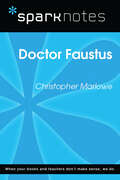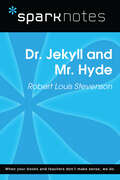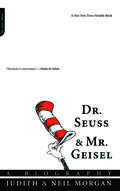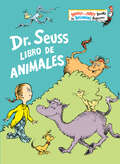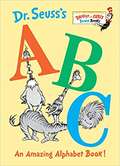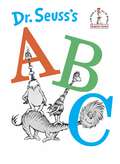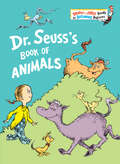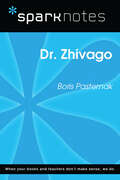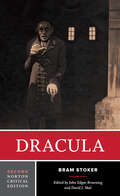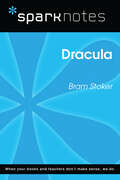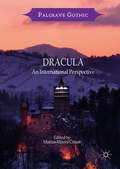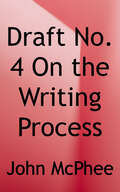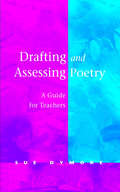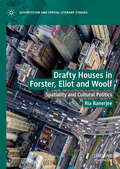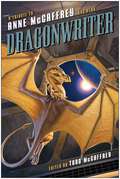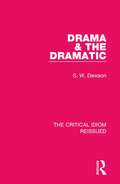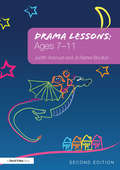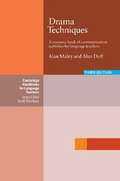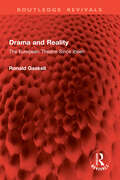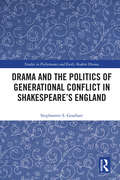- Table View
- List View
Dr. Faustus (SparkNotes Literature Guide Series)
by SparkNotesDr. Faustus (SparkNotes Literature Guide) by Christopher Marlowe Making the reading experience fun! Created by Harvard students for students everywhere, SparkNotes is a new breed of study guide: smarter, better, faster.Geared to what today's students need to know, SparkNotes provides:chapter-by-chapter analysis explanations of key themes, motifs, and symbols a review quiz and essay topics Lively and accessible, these guides are perfect for late-night studying and writing papers.
Dr. Jekyll and Mr. Hyde (SparkNotes Literature Guide Series)
by SparkNotesDr. Jekyll and Mr. Hyde (SparkNotes Literature Guide) by Robert Louis Stevenson Making the reading experience fun! Created by Harvard students for students everywhere, SparkNotes is a new breed of study guide: smarter, better, faster.Geared to what today's students need to know, SparkNotes provides:chapter-by-chapter analysis explanations of key themes, motifs, and symbols a review quiz and essay topics Lively and accessible, these guides are perfect for late-night studying and writing papers.
Dr. Johnson and Mr. Savage
by Richard Holmes"Dr. Johnson & Mr. Savage" recounts a story of a mysterious eighteenth-century friendship between Richard Savage -- poet, playwright, and convicted murderer -- and the young Samuel Johnson, an unknown provincial schoolmaster just arrived in London to seek his literary fortune. Holmes shows how the bond between Savage and Johnson revolutionized the art of biography.
Dr. Seuss & Mr. Geisel: A Biography
by Judith Morgan Neil MorganHorton, Thidwick, Yertle, the Lorax, the Grinch, Sneetches, and the Cat in the Hat are just a handful of the bizarre and beloved characters Theodor S. Geisel (1904#150;1991), alias Dr. Seuss, created in his forty-seven children's books, from 1937's And to Think That I Saw It on Mulberry Street to 1990's Oh, the Places You'll Go! During his lifetime Dr. Seuss was honored with numerous degrees, three Academy Awards, and a Pulitzer, but the man himself remained a reclusive enigma. In this first and only biography of the good doctor, the authors, his close friends for almost thirty years, have drawn on their firsthand insights as well as his voluminous papers; the result is an illuminating, intimate portrait of a dreamer who saw the world "through the wrong end of a telescope," and invited us to enjoy the view.
Dr. Seuss Libro de animales (Bright & Early Books(R))
by Dr. SeussUn libro fácil de leer sobre animales, reales e imaginarios, ilustrado por Dr. Seuss. Con un reparto de animales reales y criaturas seussianas, este texto sobre animales, sencillo y rimado, es un excelente libro de conceptos básicos, además de ser una introducción al mundo de Dr. Seuss. Ilustrado con dibujos de algunos de los más apreciados libros de Dr. Seuss, entre ellos, Un Pez Dos Peces Pez Rojo Pez Azul, ¡El señor Brown hace Muuu! ¿Podrías hacerlo tú? y Horton cuida el nido, les enseñará a los lectores principiantes a identificar los animales que forman parte del mundo que los rodea ¡y también los que solo se encuentran en los clásicos de Dr. Seuss! Historias breves, divertidas, con pocas palabras, fáciles de leer, de un ritmo alegre y vívidas ilustraciones, los libros de la colección Bright and Early Books son ideales para desarrollar el amor por la lectura en los niños.Las ediciones rimadas y en español de los clásicos de Dr. Seuss publicadas por Random House brindan la maravillosa oportunidad de disfrutar de sus historias a más de treinta y ocho millones de personas hispanohablantes en Estados Unidos. Los lectores podrán divertirse con las ediciones en español de The Cat in the Hat (El Gato Ensombrerado); Green Eggs and Ham (Huevos verdes con jamón); One Fish Two Fish Red Fish Blue Fish (Un pez, dos peces, pez rojo, pez azul); The Lorax (El Lórax); Oh, the Places You'll Go! (¡Oh, cuán lejos llegarás!); How the Grinch Stole Christmas! (¡Cómo el Grinch robó la Navidad!), y Horton Hears a Who! (¡Horton escucha a Quién!). Ideal tanto para leer en casa como en la escuela, estos libros han sido meticulosamente traducidos, respetando la rima, por autores y traductores latinoamericanos, y supervisados por Teresa Mlawer, reconocida y galardonada traductora durante más de cincuenta años.A rhymed Spanish easy reader about animals--real and imaginary--with illustrations by Dr. Seuss! Featuring a mix of real animals and Seussian creatures, this super-simple rhymed riff about animals is both a concept book and a funny introduction to the world of Dr. Seuss. Illustrated with art from beloved Dr. Seuss books--including One Fish Two Fish Red Fish Blue Fish, Mr. Brown Can Moo! Can You?, and Horton Hatches the Egg--it teaches beginning readers to identify animals in the world around them and ones only found in classic books by Dr. Seuss! Nurture a love of reading--and of animals--with this great new concept book for beginning readers! Combining brief and funny stories, easy words, catchy rhythm, and lively illustrations, Bright and Early Books are an ideal way to introduce the joys of reading to children.Random House's rhymed Spanish-language editions of classic Dr. Seuss books make the joyful experience of reading Dr. Seuss books available for the more than 38 million people in the United States who speak Spanish. Readers can enjoy over 30 different classic Dr. Seuss titles including The Cat in the Hat (El Gato Ensombrerado); Green Eggs and Ham (Huevos verdes con jamón); One Fish Two Fish Red Fish Blue Fish (Un pez dos peces pez rojo pez azul); The Lorax (El Lórax); Oh, the Places You'll Go! (¡Oh, cuán lejos llegarás!); How the Grinch Stole Christmas! (¡Cómo el Grinch robó la Navidad!); and Horton Hears a Who! (¡Horton escucha a Quién!). Perfect for home and classroom use, they are meticulously translated in rhyme by native Latin American Spanish-speakers overseen by award-winning translator Teresa Mlawer.
Dr. Seuss's ABC (Beginner Books(R))
by Dr. SeussArguably the most entertaining alphabet book ever written, this classic Beginner Book by Dr. Seuss is perfect for children learning their ABCs. Featuring a fantastic cast of zany characters—from Aunt Annie&’s alligator to the Zizzer-Zazzer-Zuzz, with a lazy lion licking a lollipop and an ostrich oiling an orange owl—Dr. Seuss&’s ABC is a must-have for every young child&’s library. Originally created by Dr. Seuss, Beginner Books encourage children to read all by themselves, with simple words and illustrations that give clues to their meaning.
Dr. Seuss's ABC: Read & Listen Edition (Beginner Books(R))
by Dr. SeussArguably the most entertaining alphabet book ever written, this classic Beginner Book by Dr. Seuss is perfect for children learning their ABCs. Featuring a fantastic cast of zany characters—from Aunt Annie&’s alligator to the Zizzer-Zazzer-Zuzz, with a lazy lion licking a lollipop and an ostrich oiling an orange owl—Dr. Seuss&’s ABC is a must-have for every young child&’s library.Originally created by Dr. Seuss, Beginner Books encourage children to read all by themselves, with simple words and illustrations that give clues to their meaning.This Read & Listen edition contains audio narration.
Dr. Seuss's Book of Animals (Bright & Early Books)
by Dr. SeussAn easy reader about animals—real and imaginary—with illustrations by Dr. Seuss!Featuring a mix of real animals and Seussian creatures, this super-simple rhymed riff about animals is both a concept book AND a funny introduction to the world of Dr. Seuss. Illustrated with art from beloved Dr. Seuss books—including One Fish Two Fish Red Fish Blue Fish,Mr. Brown Can Moo! Can You?, and Dr. Seuss's ABC—it teaches beginning readers to identify animals in the world around them and ones only found in classic books by Dr. Seuss! Nurture a love of reading—and of Seussian creatures—with this great new concept book for beginning readers!Bright and Early Books are perfect for beginning beginner readers! Launched by Dr. Seuss in 1968 with The Foot Book, Bright and Early Books use fewer and easier words than Beginner Books. Readers just starting to recognize words and sound out letters will love these short books with colorful illustrations.
Dr. Zhivago (SparkNotes Literature Guide Series)
by SparkNotesDr. Zhivago (SparkNotes Literature Guide) by Boris Pasternak Making the reading experience fun! Created by Harvard students for students everywhere, SparkNotes is a new breed of study guide: smarter, better, faster.Geared to what today's students need to know, SparkNotes provides:chapter-by-chapter analysis explanations of key themes, motifs, and symbols a review quiz and essay topics Lively and accessible, these guides are perfect for late-night studying and writing papers.
Dracula (Norton Critical Editions #0)
by Bram Stoker“In Dracula, we find a monster who takes away our agency, our choice—even as he consumes us. The fantasy of becoming a vampire is a myth of exceptionalism— nobody fantasizes about being the random peasant whom the titular Count devours. Instead, people are thrilled by the thought of turning into vampires themselves—becoming the most powerful consumer, the apex predator. And until we recognize that we have far more in common with prey than predator, we will always feel the vampire's pull. I hope Norton's vital new addition to the conversation about Stoker’s work will cause readers to look at this old story with new eyes: to question our preconceptions and refocus our own narrative lenses. Dracula remains evergreen, I'm afraid—because within our monsters... we may find ourselves.” —Kate Hamill (playwright/actor) This Norton Critical Edition includes: The first edition of the novel, published by Archibald Constable in London in 1897 and chosen by the editors in order to give readers—insofar as such a thing is possible—a more historically authentic reading experience than has been generally available. Arcane words and usages are footnoted at first appearance. Editorial matter by John Edgar Browning and David J. Skal. Eight background pieces, five of them new to the Second Edition, on Count Dracula specifically and vampires more generally; seven reviews and reactions to Dracula’s publication, five of them new to the Second Edition; and six selections, two of them new to and two others updated for the Second Edition, on Dracula’s many dramatic and filmic variations. Eleven critical essays on Dracula’s central themes, six of them new to the Second Edition. A selected bibliography. About the Series? Read by more than 12 million students over fifty-five years, Norton Critical Editions set the standard for apparatus that is right for undergraduate readers. The three-part format—annotated text, contexts, and criticism—helps students to better understand, analyze, and appreciate the literature, while opening a wide range of teaching possibilities for instructors. Whether in print or in digital format, Norton Critical Editions provide all the resources students need.? “The notes in Dracula are exactly at the right level for students. The headnotes are extremely helpful. It really does [meet the needs of today's students]. It is my favorite NCE to teach.” —Carrie D. Shanafelt, Fairleigh Dickinson University
Dracula (SparkNotes Literature Guide Series)
by SparkNotesDracula (SparkNotes Literature Guide) by Bram Stoker Making the reading experience fun! Created by Harvard students for students everywhere, SparkNotes is a new breed of study guide: smarter, better, faster.Geared to what today's students need to know, SparkNotes provides:chapter-by-chapter analysis explanations of key themes, motifs, and symbols a review quiz and essay topics Lively and accessible, these guides are perfect for late-night studying and writing papers.
Dracula: An International Perspective (Palgrave Gothic)
by Marius-Mircea CrişanThis volume analyses the role of Bram Stoker’s Dracula and its sequels in the evolution of the Gothic. As well as the transformation of the Gothic location—from castles, cemeteries and churches to the modern urban gothic—this volume explores the evolution of the undead considering a range of media from the 19th century protagonist to sympathetic contemporary vampires of teen Gothic. Based on an interdisciplinary approach (literature, tourism, and film), the book argues that the development of the Dracula myth is the result of complex international influences and cultural interactions. Offering a multifarious perspective, this volume is a reference work that will be useful to both academic and general readers.
Draft No. 4: On the Writing Process
by John McPheeDraft No. 4 is a master class on the writer's craft. In a series of playful, expertly wrought essays, John McPhee shares insights he has gathered over his career and has refined while teaching at Princeton University, where he has nurtured some of the most esteemed writers of recent decades. McPhee offers definitive guidance in the decisions regarding arrangement, diction, and tone that shape nonfiction pieces, and he presents extracts from his work, subjecting them to wry scrutiny. In one essay, he considers the delicate art of getting sources to tell you what they might not otherwise reveal. In another, he discusses how to use flashback to place a bear encounter in a travel narrative while observing that "readers are not supposed to notice the structure. It is meant to be about as visible as someone's bones." The result is a vivid depiction of the writing process, from reporting to drafting to revising--and revising, and revising. Draft No. 4 is enriched by multiple diagrams and by personal anecdotes and charming reflections on the life of a writer. McPhee describes his enduring relationships with The New Yorker and Farrar, Straus and Giroux, and recalls his early years at Time magazine. Throughout, Draft No. 4 is enlivened by his keen sense of writing as a way of being in the world.
Drafting and Assessing Poetry: A Guide for Teachers
by Sue Dymoke`This excellent book provides the reader with comprehensive coverage of all aspect of poetry teaching. The book does more than inform us - it inspires profound reflection on the best ways it support poetry writing and draws us into the debate about assessment-driven curriculum' - School Librarian `A must for trainee teachers and English departments' - Booktrusted News `Drafting and Assessing Poetry is thoroughly researched and shows how attitudes towards teaching of poetry and indeed the place of poetry on the syllabus, has changed with political fashion over the years, but more importantly, Sue Dymoke shows how a handful of contemporary poets go about drafting their work and sees this process as an essential tool in the classroom, advocating that students should keep drafting notebooks, just like real writers. Getting students, or indeed members of writing groups, to understand that one draft of a poem may not be the final or best work they can produce will never be a problem again!' - Writing in Education `Sue Dymoke's book is a much needed antidote to the ubiquitous guides to poetry analysis.... This book is well worth reading for its clarity and wealth of ideas' - Bethan Marshall, TES Teacher Magazine `Every English department should buy this remarkably comprehensive book. Inspiring approaches for teaching children to write poetry are clearly described. Sue Dymoke draws upon her extensive experience as a poet, English teacher and researcher to explore the place of writing poetry in English lessons and examinations. Her unique insights into both the writing and teaching of poetry should prove invaluable to English teachers' - Dr Mark Pike, Lecturer in English Education and Head of PGCE English, University of Leeds `It is a useful book: a theoretical text, but with a practical focus, which makes it very readable and interesting, to teachers of young people particularly, but also, to teachers of adults and indeed in parts to poetry writers themselves, particularly those interested in working in schools, or simply curious about the general process of drafting and evaluating poetry' - County Lit, Nottinghamshire County Council Literature Newsletter Drafting and Assessing Poetry offers a range of teaching strategies for developing students' poetry writing skills, and guidance about assessment approaches. Critical commentaries combine with illustrations of successful classroom practice to consider this essential but under-explored aspect of English teaching. Based on theory but with a practical dimension, the book engages readers in current critical debates about poetry teaching and its place in an assessment- driven curriculum. This book is for reflective practitioners, including trainee teachers, who want to develop their understanding of poetry teaching and to gain insights, which will inform classroom practice. It will also be useful for literacy co-ordinators, teacher educators and other advisory staff in the field of English teaching.
Drafty Houses in Forster, Eliot and Woolf: Spatiality and Cultural Politics (Geocriticism and Spatial Literary Studies)
by Ria BanerjeeThis book argues that E. M. Forster, T. S. Eliot, and Virginia Woolf engaged sustainedly with real and imagined places as sites of counter-cultural politics. These writers used architectural images in diaries, essays, novels, poems, and plays to express their dissatisfaction with imperial London: from the glorification of war to the erosion of local religious and linguistic traditions, and rigidly gendered practices in domestic and public life. Drafty Houses shows that each author experienced post-war modernity as intimate spatial dislocation—in Egypt (Forster), in the church (Eliot), or in London’s museums and streets (Woolf)—and traces connections between their personal experiences and lesser read publications to theorize about the impact of places on their writerly perspectives. By closely examining each author's negotiation of space symbolic of Englishness, empire, and global politics, Drafty Houses considers the limitsand the open-ended possibilities of liberal humanism, Christian conservatism, and feminist pacifism.
Dragonholder: The Life and Dreams of Anne McCaffrey
by Todd McCaffreyAn enthralling biography of one of the most luminous shining stars of fantasy and science fiction, world builder and dragon master Anne McCaffrey, written by her son, collaborator, and most devoted fanWhile you&’ve been to Pern . . . you haven&’t heard the stories behind the stories. I propose to fix that. When Anne McCaffrey&’s Hugo Award–winning novella &“Weyr Search&” appeared in the late 1960s as part of the novel Dragonflight, the science fiction universe was gloriously transformed as readers first experienced the exhilarating thrill of soaring with dragons. With the many Pern novels that followed, McCaffrey steadily won the hearts and unwavering devotion of millions of fans, eventually earning a permanent position on the New York Times bestseller list. Dragonholder celebrates the birth and growth of McCaffrey&’s breathtaking literary vision, as well as the momentous events of a life that was in many ways as extraordinary as the worlds and characters that McCaffrey created. No one understands or appreciates McCaffrey&’s life and work better than her son, Todd, does. In Dragonholder, her frequent coauthor and avid fan intimately examines his mother&’s childhood and early adulthood, the amazing gift of second sight she inherited from her own mother and grandmother, the trials she faced juggling a career and a family during the turbulent sixties, and her rise to literary stardom—and he reveals the events and influences that ultimately gave rise to the myriad wonders of Pern and the other miraculous worlds borne of Anne McCaffrey&’s unparalleled imagination.
Dragonwriter: A Tribute to Anne McCaffrey and Pern
by David Brin Lois McMaster BujoldWhen Anne McCaffrey passed in November 2011, it was not only those closest to her who mourned her death; legions of readers also felt the loss deeply. The pioneering science fiction author behind the Dragonriders of Pern® series crafted intricate stories, enthralling worlds, and strong heroines that profoundly impacted the science fiction community and genre. In Dragonwriter, Anne's son and Pern writer Todd McCaffrey collects memories and stories about the beloved author, along with insights into her writing and legacy, from those who knew her best. Nebula Award–winner Elizabeth Moon relates the lessons she learned from Pern's Lessa (and from Lessa's creator); Hugo Award–winner David Brin recalls Anne's steadfast belief that the world to come will be better than the one before; legendary SFF artist Michael Whelan shares (and tells stories about) never-before-published Pern sketches from his archives; and more. Join Anne's co-writers, fellow science fiction authors, family, and friends in remembering her life, and exploring how her mind and pen shaped not only the Weyrs of Pern, but also the literary landscape as we know it. Contributors include: Angelina Adams David Brin David Gerrold John Goodwin Janis Ian Alec Johnson Georgeanne Kennedy Mercedes Lackey Sharon Lee and Steve Miller Lois McMaster Bujold Elizabeth Moon Charlotte Moore Robert Neilson Jody Lynn Nye and Bill Fawcett Robin Roberts Elizabeth Ann Scarborough Wen Spencer Michael Whelan Richard J. Woods Chelsea Quinn Yarbro
Drama & the Dramatic (The Critical Idiom Reissued #10)
by S. W. DawsonFirst published in 1970, this book explores drama as literature and provides critical overviews of different aspects of drama and the dramatic. It first asks what a play is, before going on to examine dramatic language, action and tension, dramatic irony, characters and drama’s relationship with modern criticism and the novel. This book will be a valuable resource to those studying drama and English literature.
Drama From Ibsen To Brecht
by Raymond WilliamsWith typical critical flair, Raymond Williams examines the development of the dramatic form from Henrik Ibsen to Bertolt Brecht. Taking an expansive view of drama from around the world, he offers the reader profound insights into the role of theatre in society and into the workings of dramatic language. This is seminal reading for theatre-goers and literature students alike.
Drama Lessons: Ages 7-11
by Judith Ackroyd Jo Barter-BoultonDrama Lessons: Ages 7–11 offers an exciting and varied range of tried and tested lessons tailor-made for busy teachers. Drama Lessons: Ages 7–11 emerges from the continuing positive responses to Drama Lessons for Five to Eleven Year Olds (2001). In this book you will find a carefully chosen selection of the best lessons from the original book, plus some exciting new material – a combination of brand new and classic lessons. This new collection introduces Literacy Alerts which identify how the drama activities develop aspects of literacy and suggest additional literacy activities. For each lesson plan, essential resources and timing information are provided. The lessons cover a range of themes and curriculum areas. Full of pick-up-and-go lesson plans, this book will be of enormous interest to specialists and non-specialists of drama alike. All primary teachers, literacy coordinators and teaching assistants should have this book in their hands and it will give all trainee teachers a flying start in their school placements.
Drama Techniques: A Resource Book of Communication Activities for Language Teachers
by Penny Ur Alan Maley Alan DuffThe fully revised edition of this 'classic' helps teachers give their learners the tools they need to express themselves through a range of stimulating drama contexts. This completely revised edition of the classic title Drama Techniques provides: *150 ideas for interesting and productive fluency practice *a large selection of drama-based techniques which focus learners' attention on communicative tasks or activities *techniques suitable for all levels *clear instructions for the teacher *advice on how to use the techniques in the classroom
Drama and Reality: The European Theatre Since Ibsen (Routledge Revivals)
by Ronald GaskellFirst published in 1972, Drama and Reality is a lucid account of the forces that have shaped modern European theatre, and especially of the different conceptions of reality implied in different plays. Three major views are distinguished (the naturalistic, the subjective, the religious) and related to the choice between poetic and representational form in drama. In the second part of the book, Ronald Gaskell takes a number of plays which offer a distinctive vision—a personal modification of one of the views of the world already discussed—and shows how the form of each play expresses and defines this personal vision.
Drama and the Politics of Generational Conflict in Shakespeare's England (Studies in Performance and Early Modern Drama)
by Stephannie GearhartDrama and the Politics of Generational Conflict in Shakespeare’s England examines the intersection between art and culture and explains how ideas about age circulated in early modern England. Stephannie Gearhart illustrates how a variety of texts – including drama by Shakespeare, Jonson, and Middleton – placed elders’ and youths’ voices in dialogue with one another to construct the period’s ideology of age and shape elder-youth relations.
